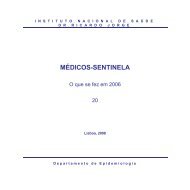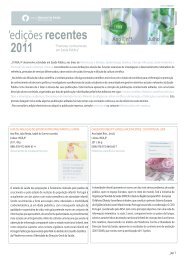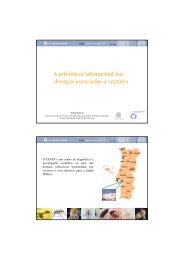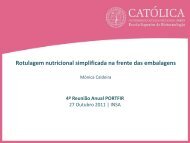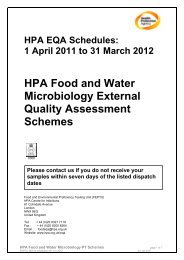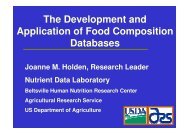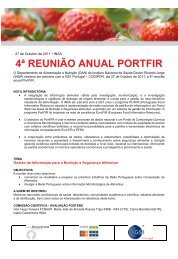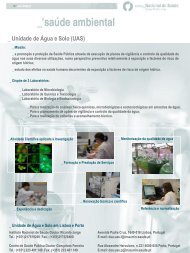European Society of Mycobacteriology - Instituto Nacional de Saúde ...
European Society of Mycobacteriology - Instituto Nacional de Saúde ...
European Society of Mycobacteriology - Instituto Nacional de Saúde ...
Create successful ePaper yourself
Turn your PDF publications into a flip-book with our unique Google optimized e-Paper software.
PP-27<br />
Mutational analysis <strong>of</strong> genes associated with<br />
resistance to injectable second-line drugs in Mycobacterium<br />
tuberculosis clinical isolates from Lisbon, Portugal<br />
João Perdigão 1 , Ana Ferreira 1 , Ana Malaquias 1 , Rita Macedo 2 , Laura Brum 2 and Isabel Portugal. 1,2<br />
1 - Centro <strong>de</strong> Patogénese Molecular, URIA, Faculda<strong>de</strong> <strong>de</strong> Farmácia da Universida<strong>de</strong> <strong>de</strong> Lisboa<br />
2 - Laboratório <strong>de</strong> Micobactérias, Centro <strong>de</strong> Bacteriologia, <strong>Instituto</strong> <strong>Nacional</strong> <strong>de</strong> Saú<strong>de</strong> Dr. Ricardo Jorge<br />
Objectives<br />
Multidrug resistance (MDR) constitutes a serious problem to tuberculosis (TB) control program in Portugal. An even<br />
more serious threat is the one posed by the high rate <strong>of</strong> extensive drug-resistant TB (XDR-TB). Our laboratory has<br />
already shown that high rates <strong>of</strong> this form <strong>of</strong> TB exist in Lisbon. Given the fact that MDR-TB and XDR-TB are currently<br />
associated with a limited number <strong>of</strong> genetic clusters, mainly Lisboa family clusters, the diversity <strong>of</strong> genetic polymorphisms<br />
conferring resistance to second-line drugs is also probably limited. In this study we inten<strong>de</strong>d to characterize the genetic<br />
polymorphisms associated with resistanace to second-line injectable drugs and to assess the clinical isolates clonality.<br />
Methods<br />
We have analyzed 19 MDR-TB strains resistant to one or more second-line injectable drugs, collected from several hospital<br />
units across Lisbon Health Region during the year <strong>of</strong> 2005. All isolates were typed by Mycobacterial Interspersed<br />
Repetitive Units (MIRU-VNTR) and, screened for mutations in tlyA and rrs genes.<br />
Results<br />
Three different mutations were i<strong>de</strong>ntified on tlyA gene and another three at rrs gene. Overall, 9 isolates had mutations in<br />
tlyA gene and 8 isolates had mutations in rrs gene; two isolates didn’t have any mutation in either gene. The most frequent<br />
mutations found were A1401G in rrs gene (6/19) and 755InsGT in tlyA gene (6/19). We also verified that there was no<br />
overlapping <strong>of</strong> mutations from different genes. The genotyping analysis revealed that the isolates could be distributed<br />
through two different MIRU-VNTR genetic clusters: Lisboa3 and Q1. Cluster Q1 contained all clinical isolates bearing the<br />
A1401G mutation in rrs gene, while Lisboa 3 cluster contained all isolates that had the 755InsGT mutation in tlyA gene.<br />
Conclusion<br />
We have i<strong>de</strong>ntified several mutations that might be associated with resistance to different but related second-line drugs:<br />
kanamycin, amikacin and capreomycin. The two most prevalent mutations were associated with different genetic clusters,<br />
which suggests recent transmission and, ultimately, that XDR-TB transmission is taking place. The most prevalent<br />
mutations associated with injectable second-line drugs have therefore been <strong>de</strong>fined, which opens the way for molecular<br />
<strong>de</strong>tection <strong>of</strong> resistance to second-line drugs in the region.<br />
<strong>European</strong> <strong>Society</strong> <strong>of</strong> <strong>Mycobacteriology</strong> | 30 th Annual Congress | July 2009 | Porto - Portugal<br />
99



